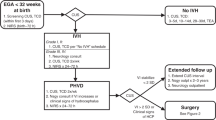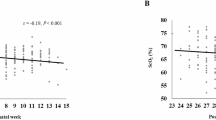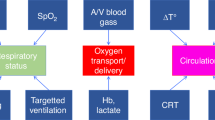Abstract
Premature infants exposed to chorioamnionitis are at increased risk for periventricular leukomalacia (PVL) and intraventricular hemorrhage (IVH), lesions that may result from inflammation and/or fluctuations in cerebral blood flow. The effect of chorioamnionitis on near-infrared spectroscopy (NIRS) measures of cerebral oxygen delivery has not been evaluated previously. Forty-nine infants born at 25–31 6/7 wk gestation underwent NIRS examination on d 1, 2, 3, and 7 of life. Variability in NIRS tracings was analyzed by partitioning each tracing into three components: long-term, intermediate, and short-term variability; the latter two components were analyzed. Chorioamnionitis-exposed infants manifest reduced intermediate variability in cerebral oxygenated and deoxygenated Hb but not total Hb. Infants with severe IVH/PVL had the lowest intermediate variability on d 1. Short-term variability was similar between chorioamnionitis-exposed and unexposed infants, and between infants with versus without severe IVH or PVL. We conclude that intermediate-term variability in NIRS cerebral oxygen delivery is reduced in chorioamnionitis-exposed infants. We speculate that intermediate variability represents the important time frame for evaluating the pathogenesis of perinatal brain injury. Further studies are needed to determine how these findings relate to cerebral blood flow autoregulation and oxygen utilization in premature infants.
Similar content being viewed by others
Log in or create a free account to read this content
Gain free access to this article, as well as selected content from this journal and more on nature.com
or
Abbreviations
- IVH:
-
intraventricular hemorrhage
- NIRS:
-
near-infrared spectroscopy
- PVL:
-
periventricular leukomalacia
References
De Felice C, Toti P, Laurini RN, Stumpo M, Picciolini E, Todros T, Tanganelli P, Buonocore G, Bracci R 2001 Early neonatal brain injury in histologic chorioamnionitis. J Pediatr 138: 101–104
Dammann O, Leviton A 1997 Maternal intrauterine infection, cytokines, and brain damage in the preterm newborn. Pediatr Res 42: 1–8
Zupan V, Gonzalez P, Lacaze-Masmonteil T, Boithias C, d'Allest AM, Dehan M, Gabilan JC 1996 Periventricular leukomalacia: risk factors revisited. Dev Med Child Neurol 38: 1061–1067
de Vries LS, Regev R, Dubowitz LM, Whitelaw A, Aber VR 1988 Perinatal risk factors for the development of extensive cystic leukomalacia. Am J Dis Child 142: 732–735
Lou HC 1994 Hypoxic-hemodynamic pathogenesis of brain lesions in the newborn. Brain Dev 16: 423–431
Back SA, Han BH, Luo NL, Chricton CA, Xanthoudakis S, Tam J, Arvin KL, Holtzman DM 2002 Selective vulnerability of late oligodendrocyte progenitors to hypoxia-ischemia. J Neurosci 22: 455–463
Greisen G, Borch K 2001 White matter injury in the preterm neonate: the role of perfusion. Dev Neurosci 23: 209–212
Young RS, Hernandez MJ, Yagel SK 1982 Selective reduction of blood flow to white matter during hypotension in newborn dogs: a possible mechanism of periventricular leukomalacia. Ann Neurol 12: 445–448
Yoon BH, Romero R, Kim CJ, Koo JN, Choe G, Syn HC, Chi JG 1997 High expression of tumor necrosis factor-alpha and interleukin-6 in periventricular leukomalacia. Am J Obstet Gynecol 177: 406–411
Noetzel MJ, Brunstrom JE 2001 The vulnerable oligodendrocyte: inflammatory observations on a cause of cerebral palsy. Neurology 56: 1254–1255
Perlman JM, McMenamin JB, Volpe JJ 1983 Fluctuating cerebral blood-flow velocity in respiratory-distress syndrome. Relation to the development of intraventricular hemorrhage. N Engl J Med 309: 204–209
Tsuji M, Saul JP, du Plessis A, Eichenwald E, Sobh J, Crocker R, Volpe JJ 2000 Cerebral intravascular oxygenation correlates with mean arterial pressure in critically ill premature infants. Pediatrics 106: 625–632
Van Bel F, Van de Bor M, Stijnen T, Baan J, Ruys JH 1989 Cerebral blood flow velocity changes in preterm infants after a single dose of indomethacin: duration of its effect. Pediatrics 84: 802–807
Yanowitz TD, Baker RW, Sobchak Brozanski B 2003 Prophylactic indomethacin reduces grades III and IV intraventricular hemorrhages when compared to early indomethacin treatment of a patent ductus arteriosus. J Perinatol 23: 317–322
Park MK, Menard SM 1987 Accuracy of blood pressure measurement by Dinamap monitor in infants and children. Pediatrics 79: 907–914
Redline RW, Faye-Petersen O, Heller D, Qureshi F, Savell V, Vogler C 2003 Amniotic infection syndrome: nosology and reproducibility of placental reaction patterns. Pediatr Dev Pathol 6: 435–448
Volpe JJ 2001 Hypoxic-ischemic encephalopathy: clinical aspects. Volpe JJ(ed) Neurology of the Newborn,. W.B. Saunders, Philadelphia 343–345
Papile LA, Burstein J, Burstein R, Koffler H 1978 Incidence and evolution of subependymal and intraventricular hemorrhage: a study of infants with birth weights less than 1,500 gm. J Pediatr 92: 529–534
Cleveland WS 1979 Robust locally weighted regression and smoothing of scatterplots. J Am Stat Assoc 74: 829–836
Gomez R, Romero R, Ghezzi F, Yoon BH, Mazor M, Berry SM 1998 The fetal inflammatory response syndrome. Am J Obstet Gynecol 179: 194–202
Chaiworapongsa T, Romero R, Kim JC, Kim YM, Blackwell SC, Yoon BH, Gomez R 2002 Evidence for fetal involvement in the pathologic process of clinical chorioamnionitis. Am J Obstet Gynecol 186: 1178–1182
Pacora P, Chaiworapongsa T, Maymon E, Kim YM, Gomez R, Yoon BH, Ghezzi F, Berry SM, Qureshi F, Jacques SM, Kim JC, Kadar N, Romero R 2002 Funisitis and chorionic vasculitis: the histological counterpart of the fetal inflammatory response syndrome. J Matern Fetal Neonatal Med 11: 18–25
Yoon BH, Romero R, Kim CJ, Jun JK, Gomez R, Choi JH, Syn HC 1995 Amniotic fluid interleukin-6: a sensitive test for antenatal diagnosis of acute inflammatory lesions of preterm placenta and prediction of perinatal morbidity. Am J Obstet Gynecol 172: 960–970
Yanowitz TD, Jordan JA, Gilmour CH, Towbin R, Bowen A, Roberts JM, Brozanski BS 2002 Hemodynamic disturbances in premature infants born after chorioamnionitis: association with cord blood cytokine concentrations. Pediatr Res 51: 310–316
Gomez R, Romero R, Ghezzi F, Yoon BH, Mazor M, Berry SM 1998 The fetal inflammatory response syndrome. Am J Obstet Gynecol 179: 194–202
Yanowitz TD, Baker RW, Roberts JM, Brozanski BS 2004 Low blood pressure among very-low-birth-weight infants with fetal vessel inflammation. J Perinatol 24: 299–304
Morren G, Naulaers G, Lemmerling P, Van Huffel S, Casaer P, Devlieger H 2003 Quantitation of the concordance between cerebral intravascular oxygenation and mean arterial blood pressure for the detection of impaired autoregulation. Adv Exp Med Biol 510: 403–408
Pryds O, Greisen G, Lou H, Friis-Hansen B 1990 Vasoparalysis associated with brain damage in asphyxiated term infants. J Pediatr 117: 119–125
Elwell C 1995 A Practical User's Guide to Near-Infrared Spectroscopy. UCL Reprographics, London
Villringer K, Minoshima S, Hock C, Obrig H, Ziegler S, Dirnagl U, Schwaiger M, Villringer A 1997 Assessment of local brain activation. A simultaneous PET and near-infrared spectroscopy study. Adv Exp Med Biol 413: 149–153
England M 1988 Normal Development in the Central Nervous System. Wellcome Trust, London
Inder TE, Huppi PS, Warfield S, Kikinis R, Zientara GP, Barnes PD, Jolesz F, Volpe JJ 1999 Periventricular white matter injury in the premature infant is followed by reduced cerebral cortical gray matter volume at term. Ann Neurol 46: 755–760
Pinto-Martin JA, Riolo S, Cnaan A, Holzman C, Susser MW, Paneth N 1995 Cranial ultrasound prediction of disabling and nondisabling cerebral palsy at age two in a low birth weight population. Pediatrics 95: 249–254
Wu YW, Colford JM Jr 2000 Chorioamnionitis as a risk factor for cerebral palsy: a meta-analysis. JAMA 284: 1417–1424
Leviton A 1993 Preterm birth and cerebral palsy: is tumor necrosis factor the missing link?. Dev Med Child Neurol 35: 553–558
Nelson KB, Grether JK, Dambrosia JM, Walsh E, Kohler S, Satyanarayana G, Nelson PG, Dickens BF, Phillips TM 2003 Neonatal cytokines and cerebral palsy in very preterm infants. Pediatr Res 53: 600–607
Wood NS, Costeloe K, Gibson AT, Hennessy EM, Marlow N, Wilkinson AR 2005 The EPICure study: associations and antecedents of neurological and developmental disability at 30 months of age following extremely preterm birth. Arch Dis Child Fetal Neonatal Ed 90: F134–F140
Bada HS, Korones SB, Perry EH, Arheart KL, Ray JD, Pourcyrous M, Magill HL, Runyan W 3rd, Somes GW, Clark FC, et al. 1990 Mean arterial blood pressure changes in premature infants and those at risk for intraventricular hemorrhage. J Pediatr 117: 607–614
Dammann O, Allred EN, Kuban KC, Van Marter LJ, Pagano M, Sanocka U, Leviton A 2002 Systemic hypotension and white-matter damage in preterm infants. Dev Med Child Neurol 44: 82–90
Author information
Authors and Affiliations
Corresponding author
Additional information
Supported by National Institutes of Health grant 1 K23 HD01317-01 and a grant from the Crown Center for Research on Women and Newborn Health.
Rights and permissions
About this article
Cite this article
Yanowitz, T., Potter, D., Bowen, A. et al. Variability in Cerebral Oxygen Delivery Is Reduced in Premature Neonates Exposed to Chorioamnionitis. Pediatr Res 59, 299–304 (2006). https://doi.org/10.1203/01.pdr.0000196738.03171.f1
Received:
Accepted:
Issue date:
DOI: https://doi.org/10.1203/01.pdr.0000196738.03171.f1
This article is cited by
-
Changes in Cerebral Regional Oxygen Saturation Variability in Neonates Undergoing Cardiac Surgery: A Prospective Cohort Study
Pediatric Cardiology (2023)
-
Cerebral regional oxygen saturation variability in neonates following cardiac surgery
Pediatric Research (2021)
-
EEG maturation and stability of cerebral oxygen extraction in very low birth weight infants
Journal of Perinatology (2016)
-
Postnatal infection is associated with widespread abnormalities of brain development in premature newborns
Pediatric Research (2012)
-
Cerebral autoregulation in the first day after preterm birth: no evidence of association with systemic inflammation
Pediatric Research (2012)



